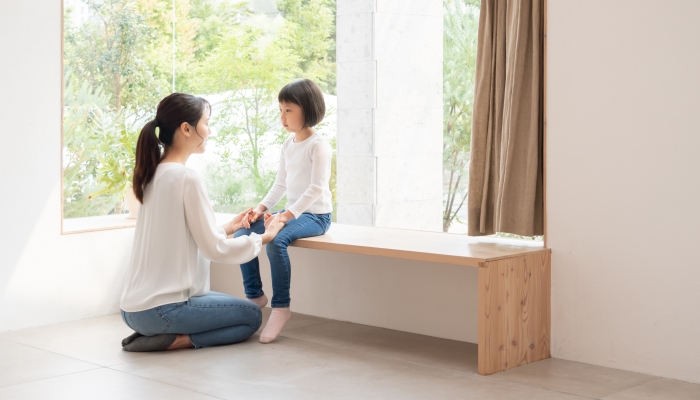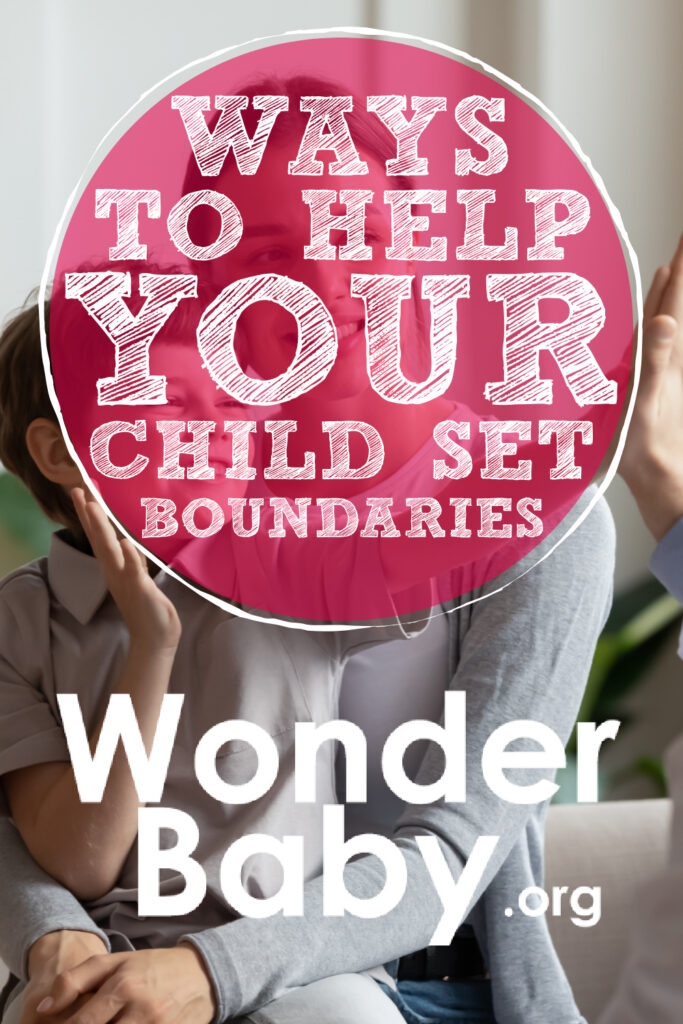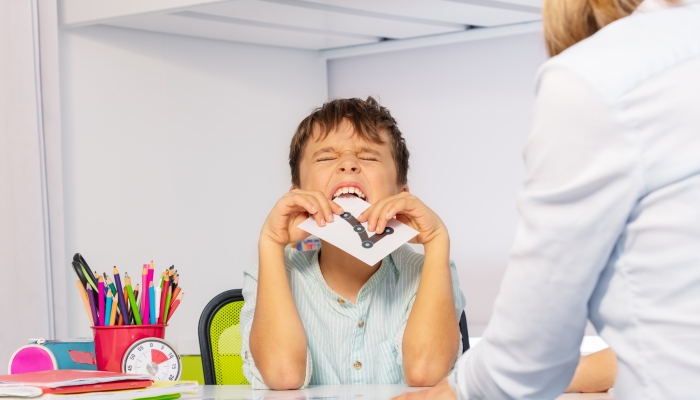3 Ways To Help Your Child Set Boundaries

- Establishing clear limits and standards for acceptable behavior helps children learn the basics of healthy relationships.
- Respecting our children’s boundaries, whether or not we agree with them, gives children a solid sense of self and builds confidence.
- Parents can role model respect for their own boundaries and those of others by the way they show awareness of the limits of those around them.
Healthy personal boundaries are a popular topic these days among kids and adults.
A boundary can refer to physical limits, like a hedge, brick wall, or no-fly zone. Other times, boundaries serve as a metaphor for the mental and emotional limits that guide how we protect our innermost selves and respond to others.
Awareness of our own limits and respecting those of the people around us is a skill that begins at a young age and is refined throughout our lives.
While children may have an innate sense of right and wrong, part of our role as parents is helping kids learn about their own emotions, teaching children to set emotional and mental boundaries, and how to respond appropriately when those limits are challenged.
Read on to learn three simple ways to help your child set boundaries that will assist them in developing the art of respect.
Set Clear Rules and Expectations

Setting boundaries is more like helping a child learn to follow clear limits and rules than punishment for “bad” or unsafe behavior.
It may help to think of healthy boundaries as the rules of the road in driver’s education. The differently colored lines and various road signs aren’t there to punish people—instead, they help a driver know the rules of driving in that particular location and prevent accidents caused by unsafe behavior.
As parents, we can help our children respect our boundaries and those of others by consistently setting and enforcing rules. Regularly teaching and applying behavior standards in your home is a good parenting practice that aids in boundary awareness and development.
For example, if your house rule is that hitting siblings is unacceptable behavior, consider the consistent use of friendly reminders or phrases such as, “Ouch! We use our words, not our hands.”
When adults repeatedly use this cue, followed by taking a break or having a “do-over”, the child remembers that they’ve gone past set boundaries.
Staff at Cornell University11. Making and Enforcing Rules. Cornell Cooperative Extension. 2015. https://ccetompkins.org/family/parent-pages/discipline/making-and-enforcing-rules encourage parents and teachers to consider these guidelines when enforcing rules with children:
- Calm, consistent, and fair application of rule enforcement is vital in teaching children boundaries. Limits and the purpose behind them lose meaning without consistent enforcement.
- Regularly providing young children with a few friendly reminders about expected behavior helps them learn and internalize limits. Consider posting expectations (in words or pictures) in a central location in your home or classroom or asking kids to say and explain the rule to you.
- Children need time and lots of practice to learn rules and boundaries at home and in the classroom.
- Expect kids to test and push boundaries. Children of all ages do this to learn the limits of those around them and whether or not they can expect those boundaries and rules to be consistently applied.
- Use natural or logical consequences for rule-breaking or boundary violations. For example, if a child whacks their sibling with a block, they lose the ability to play with that toy for a set time.
While consistently setting limits and ensuring their enforcement is taxing, in the long run, it sends a clear message to children about the feelings and rights of others.
Respect Their Choices

Validating and respecting personal boundaries set by our children is an important part of healthy relationships. Knowing that we are worthy of having personal boundaries and that our wishes will be honored is part of developing healthy self-esteem and gives children a strong sense of self.
As children begin setting and enforcing their own boundaries, we can give them ample opportunity to practice these skills within the context of the family by showing respect for their choices.
These areas can include:
Physical Contact
From an early age, many parents encourage their children to show a form of physical acknowledgment when visitors or another family member arrives—even if the child displays strong avoidant cues or appears to feel uncomfortable.
This desire can stem from wanting to teach children an awareness of other people’s feelings or that a parent feels anxious about or responsible for how the child is interacting with those around them.
Clinical psychologist Dr. Laura Markham22. What Every Parent Needs to Know to Keep Your Child Safe From Sexual Abuse. Peaceful Parent Happy Kids. https://www.peacefulparenthappykids.com/read/prevent-sex-abuse-educate-child-body-safety suggests that parents set expectations early with visitors and family members that the child is the one who decides what level of physical contact, if any, they are willing to give during interactions.
Offering children the option of “hug, handshake, or high five” helps children develop awareness of their own needs and feel safe about the level of touch allowed with adults—even familiar ones—in a given interaction,
Natural Consequences
Expect children to push back and test boundary limits as part of achieving the developmental skill of making independent choices (autonomy).
In these situations, the use of natural consequences can be a far better teacher than a long explanation given by the best parent on the block.
Simply stated, natural consequences mean the child feels responsible for the logical or natural results of their choices without involvement from an adult.
At different points in my children’s lives, this concept has looked like missing a favorite bedtime story because they chose not to stay on task while getting ready for bed or being cold during recess because they chose not to bring their snow gear that day.
It’s also important to balance safety and risk awareness when setting boundaries through natural consequences: The goal is to build self-awareness, not endanger our children.
Lead By Example

Have you ever tried to have a private conversation with another adult while your child was in the room? If you have, you’ll know that children are constantly observing their adults—even if it seems like they’re not paying attention.
Children first learn emotional regulation and boundary behavior33. Jacobson, R.. Teaching Kids About Boundaries. Child Mind Institute. 2024. https://childmind.org/article/teaching-kids-boundaries-empathy by watching their parents.
As parents, we can set a good example for our children in healthy boundaries by the way we:
- Ask for consent from other adults (and children) before initiating physical contact.
- Are present and fully listen to what’s said (verbally and nonverbally) by those around us.
- Respect the stated boundaries or wishes given.
- Honor requests for personal space when given.
- Ask for and receive forgiveness when we unintentionally push past the boundaries of others.
- Take ownership of our behavior and appropriately assert ourselves when our boundaries are threatened.
- Take time for self-care and reflection to heal from boundary violations.
When adults are open to receiving constructive criticism from children and other family members about the way they interact with the boundaries of those around them, connection is built. This, in turn, strengthens the bond between family members and increases resiliency for individuals and the family as a whole.
While setting boundaries with our children can feel difficult, this important skill is crucial for kids to learn how to respect their own limits and those of the people around them. When children feel responsible for their own behavior and know appropriate ways to respond when their limits are strained, they are better able to positively contribute in other social situations.
References
- Making and Enforcing Rules. Cornell Cooperative Extension. (2015, August 8). https://ccetompkins.org/family/parent-pages/discipline/making-and-enforcing-rules
- What Every Parent Needs to Know to Keep Your Child Safe From Sexual Abuse. Peaceful Parent Happy Kids. (n.d.). https://www.peacefulparenthappykids.com/read/prevent-sex-abuse-educate-child-body-safety
- Jacobson, R. (2024, April 19). Teaching Kids About Boundaries. Child Mind Institute. https://childmind.org/article/teaching-kids-boundaries-empathy

The information WonderBaby provides is not intended to be, and does not constitute, medical or other health advice or diagnosis and should not be used as such. Always consult with a qualified medical professional about your specific circumstances.
Related Posts

Behavior
Understanding Intermittent Explosive Disorder in Children
Are you worried about your child’s unexpected aggression and explosive behaviors? Learn how to support a child with intermittent explosive disorder.

Behavior
5 Emotional Regulation Activities for Kids
Want to teach your child how to regulate emotions? Here are emotional regulation activities for kids that can help!

Behavior, Special Needs
5 Tips for Dining Out with Children Who Have Sensory Sensitivities
Worried about dining out with sensory sensitivities? Try these tips for less stress and more fun the next time you take your family out to eat.